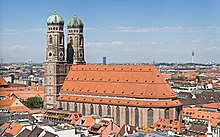Frauenkirche, Munich
| Frauenkirche | |
|---|---|
| Dom zu Unserer Lieben Frau | |
| English: Cathedral of Our Lady | |
 |
|
| 48°8′19″N 11°34′26″E / 48.13861°N 11.57389°ECoordinates: 48°8′19″N 11°34′26″E / 48.13861°N 11.57389°E | |
| Location | Frauenplatz 1 Munich, Bavaria |
| Country | Germany |
| Denomination | Roman Catholic |
| Website | www |
| History | |
| Consecrated | 1494 |
| Architecture | |
| Status | Co-cathedral |
| Functional status | Active |
| Architect(s) | Jörg von Halsbach |
| Architectural type | Cathedral |
| Style |
Gothic Renaissance (domes) |
| Years built | preced. 12th century actual 1468-1488 |
| Completed | 1524 (domes added) |
| Specifications | |
| Length | 109 metres (358 ft) |
| Width | 40 metres (130 ft) |
| Number of domes | 2 |
| Number of towers | 2 |
| Tower height | 99 metres (325 ft) |
| Administration | |
| Archdiocese | Munich and Freising |
| Clergy | |
| Archbishop | Reinhard Cardinal Marx |
| Priest(s) | Hans-Georg Platschek |
| Laity | |
| Director of music | Lucia Hilz (kapellmeister) |
| Organist(s) | Hans Leitner |
The Frauenkirche (Full name: German: Dom zu Unserer Lieben Frau, English: Cathedral of Our Dear Lady) is a church in the Bavarian city of Munich that serves as the cathedral of the Archdiocese of Munich and Freising and seat of its Archbishop. It is a landmark and is considered a symbol of the Bavarian capital city. Although called "Münchner Dom" (Munich Cathedral) on its website and URL, the church is always referred to as "Frauenkirche" by locals.
The church towers are widely visible because of local height limits. According to the narrow outcome of a local plebiscite, city administration prohibits buildings with a height exceeding 99 m in the city center. Since November 2004, this prohibition has been provisionally extended outward and as a result, no buildings may be built in the city over the aforementioned height. The south tower which is normally open to those wishing to climb the stairs, will, on completion of its current renovation, offer a unique view of Munich and the nearby Alps.
Right next to the town's first ring of walls, a Romanesque church was added in the 12th century, replacing a former, late romanesque building and serving as a second city parish following Alter Peter church (its tower nicknamed 'Ole Pete'), which is the oldest. The current late Gothic construction replaced this older church and was commissioned by Duke Sigismund and the people of Munich in the 15th century.
The cathedral was erected in only 20 years' time by Jörg von Halsbach. For financial reasons and due to the lack of a nearby stone pit, brick was chosen as building material. Construction began in 1468. Since the cash resources were exhausted in 1479, Pope Sixtus IV granted an indulgence.
The two towers (north tower 98.57 m, south tower 0.12 m less) were completed in 1488 and the church was consecrated in 1494. However, due to lack of funds, the planned, tall, open-work spires typical of the Gothic style could not be built and the towers had to stay unfinished until 1525. Hartmann Schedel printed a view of Munich including the uncovered towers in his famous Nuremberg Chronicle, also known as Schedel's World Chronicle. However, because rainwater was regularly penetrating the temporary roofing in the tower's ceilings, a decision was made to complete them in a budget-priced design. This is how the building got its famous domes atop each tower and the church became such a non-interchangeable landmark. Their design was modelled on the Dome of the Rock in Jerusalem, which in turn took a lead from late Byzantine architecture and was at that time falsely considered to be Solomon's original temple.
...
Wikipedia

